Puppies have a lot of hyper energy and very short attention spans.
They are also infinitely curious and want to put everything that they see in their little mouths. This can make puppy obedience training something of a challenge.
When it comes to puppy training, we want to get our puppy to repeat good behaviors, and stop bad behaviors. The more a puppy practices a behavior, the more likely she will repeat it. Therefore, by encouraging good behaviors, we ensure that she will have a good repertoire of people friendly actions to draw upon when she grows up.
Here, we deal with the 3 primary elements of puppy obedience training –
- How to communicate consistently and effectively with a puppy.
- How to encourage good puppy behaviors.
- How to discourage bad puppy behaviors.

1. How to Communicate with Puppy

The first two words I teach my puppy are “Yes” and “No”.
“Yes” is used to mark a desirable behavior and “No” is used to mark an undesirable behavior.
Yes is usually followed by a positive consequence (e.g. a food reward, affection, toys), and No is usually followed by a negative consequence (e.g. withdrawal of attention, timeout).
In fact, we do not need to use the words “Yes” and “No”, and can pick whatever mark-words we want. The best mark-words are unique, and do not frequently come up in normal conversation. This helps to prevent confusion with our dogs.
For my dogs, I use Ack-Ack as a no-mark and Good-Boy or Good-Girl as a yes-mark.
- When my puppy does something good, I say “Good-Girl” and present her with a small treat reward.
- When my puppy does something bad, I say “Ack-Ack” and redirect her into doing something positive.
Consistency is very important while communicating with our dogs. We want to stick to the same yes-mark and no-mark.
In addition, we also want to establish very consistent rules and a fixed routine. This helps our puppy understand what is expected of her, as well as what she can expect from us.


One of the first things that I do with a new puppy, is set up a fixed routine. My puppy schedule includes playing time, training time, walking time, feeding time, and the ever important sleeping time. I try to keep the schedule consistent, so that each of these activities happen at around the same time every day.
Keeping a fixed schedule is good for me, and good for Puppy. It allows me to be more efficient about getting things done, and it sets aside some me-time while Puppy is sleeping and resting in her crate.
It also helps get a puppy accustomed to a new environment, without being overly stressed. In the beginning, everything is new, foreign, and possibly scary for a new dog. A fixed schedule helps to reduce stress, increase trust, and quickly integrates her into the existing family rhythm.
Similarly, a consistent set of rules will help to avoid confusion, and hasten the puppy learning process.
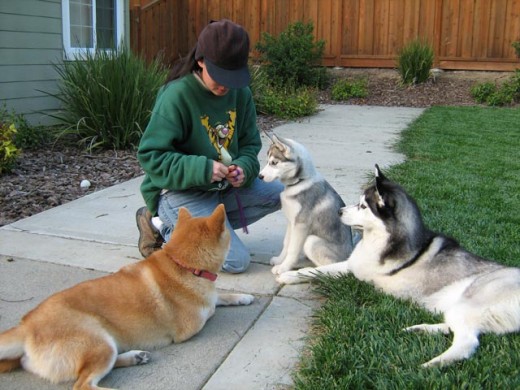
2. How to Encourage Good Behaviors
Puppy obedience training and even adult dog training is centered around two key areas-
- How to encourage and get puppy to repeat good behaviors.
- How to discourage and get puppy to stop bad behaviors.
It is important to recognize though that what we see as good and bad behaviors may not coincide with what our dog considers to be good and bad behaviors.
Dogs, even puppies, think for themselves and have needs of their own.
Therefore, we want to use our newly established communication system to teach our puppy what is good and bad for us. In addition, we must also motivate our dog so that she actually cares about our human values, which very likely, make little or no sense to her.


We encourage good behaviors by using the yes-mark, as soon as our dog finishes doing something good.
For example, when our puppy finishes doing a Sit we say “Good-Girl!” and then present her with a reward. The yes-mark is very helpful in training because it allows us to immediately mark the behavior that we want to reward.
To effectively train our puppy, we want to clearly indicate which action she is being rewarded for. If we wait too long, she will have moved on to something else, and we may inadvertently reward the wrong behavior.
Therefore, quickly use the yes-mark as soon as our dog finishes a good behavior. Then, we can take more time to present Puppy with her reward.

3. How to Stop Bad Behaviors
When it comes to stopping bad dog behaviors most of us think of applying a physical punishment, for example spanking the dog, jabbing the dog with our fingers, or giving the dog a collar correction.
These techniques apply pain to the dog, at which point the dog may stop her current behavior in order to avoid further pain and stress.
However, such pain based techniques are risky. If they are not executed with exactly the right force, timing, and redirection, they may cause more behavioral issues down the road; even aggression. It is especially risky to apply such techniques to puppies because of their young minds, and still developing bodies.
How then can we stop bad puppy behavior?

I have found that the best way to stop bad behavior is through the control of resources. *We* naturally control everything that a puppy wants, including food, toys, freedom, affection, and play.
To encourage good behaviors, we motivate our puppy by giving her something that she wants.
To discourage bad behaviors, we motivate our puppy by taking away something that she values, for example her freedom, or our attention and affection.
Note – This does not mean that we should tease our puppy and take away food while she is eating, or forcibly remove a toy that she is playing with. Doing so can encourage food aggression or resource guarding behavior.
What works best is to withhold something that my puppy wants, but does not yet have. Another possibility is to take away a privilege, such as withdrawing my attention or restricting her freedom.

When my puppy bites at my hands, I give her a no-mark (Ack-ack) and then redirect her to do something else, for example, chew on a toy. If Puppy redirects, I give her a yes-mark (Good-Girl), and reward her with something that she really wants, such as a yummy treat.
If Puppy ignores the no-mark and continues to bite at me, I withdraw my attention by standing up, folding up my arms, and turning away from her. In this way, she loses a valued play-mate, and no longer gets to engage in something fun.
If Puppy escalates her behavior and starts to jump on me or bite my clothes, I take away an even more important privilege; her freedom. I do this by calmly saying Timeout, and then taking my puppy to a boring but safe timeout area.
Puppies often bite at us to initiate play or to get our attention. We can effectively stop puppy biting by teaching her the following-
- Biting = No attention and no play,
- No biting = Attention, play, and treats.
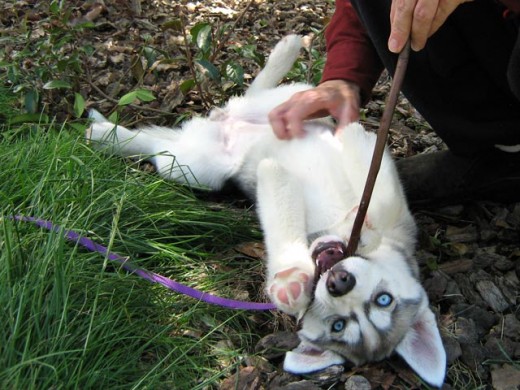
How to Train a Puppy
To stop bad behavior, I have found that it is important to –
- Start by redirecting Puppy into doing something positive. In this way, we turn a negative situation into a positive one. We not only get our dog to do what we want, but also teach her that following our commands, is the fastest way to get to her heart’s desires.
- Make the punishment suit the crime. I always start small and give my puppy many opportunities to choose a path for success. If she continues or escalates her bad behavior, then I slowly escalate her punishment.
- Stay calm at all times. Puppies have high energy and are easily distracted. If we get angry or frustrated, we will only inject more bad energy into an already volatile situation. This will likely cause our puppy to lose focus, become more hyper, and behave in an even more erratic fashion. If we want our dog to be calm, we must stay calm ourselves.
- Set Puppy up for success. Carefully manage our puppy and only expose her to situations that we think she can handle. For example, start by introducing her to new objects that are not moving, then slowly move on to moving objects, then objects that move and make noise, and so on. Start small and slowly move up to bigger things. The more successful a puppy is, the more confident she will become, and the more balanced she will be when she grows up.
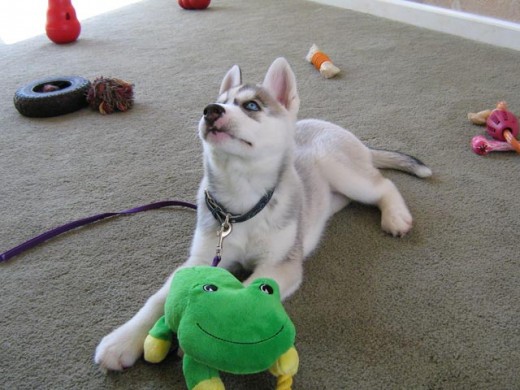
Goal of Puppy Obedience
The goal of puppy obedience is to learn how to communicate with our puppy, and teach her how to live well and harmoniously with us.
Obedience training can also help to protect our puppy from inadvertently harming herself and others, or from engaging in activities that may be detrimental to her health (e.g. over-eating, walking on glass).
Obedience training is *not* for acting out our anger, or venting our frustrations when our puppy poops on our furniture, eats poop, and spreads garbage all over our expensive designer couch.
We are not perfect, and Puppy is not perfect. In the initial stages, mistakes will be made, some of which may lead to chewed up designer shoes, scratched kitchen cabinets, and stained carpets. However, this is all part of the learning process.
Puppies, and indeed all dogs do not perform bad behaviors just to piss us off, make us angry, or exact revenge.
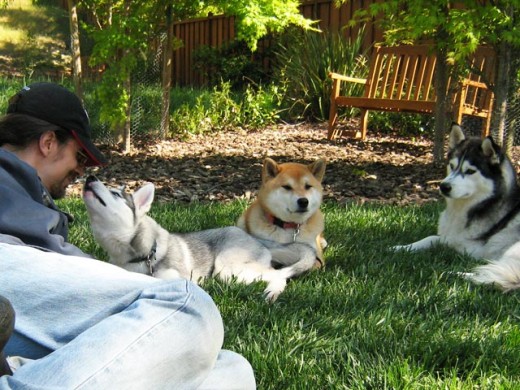
Puppies Acting Badly
Puppies or dogs act badly because …
- They do not know that something is bad because we did not teach them properly.
- They were stressed and started chewing, digging, or even pooping in order to relieve that stress (displacement behaviors).
- They felt threatened and thought it was necessary to protect themselves, or their belongings.
The key to puppy obedience training is in learning to see things from our dog’s point of view.
Once we understand what motivates our puppy, we can prevent undesirable actions and encourage desirable ones.
Dogs spend a lot of time observing us, understanding what makes us tick, and making us happy. The least that we can do, is try to return the favor.
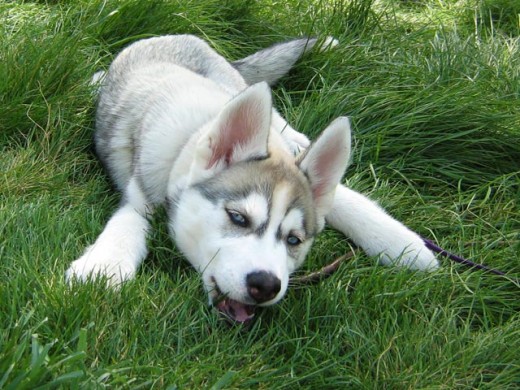
My 10 week old Siberian husky puppy is very playful but at time she becomes very aggressive towards us. Her nose will scrunch up and try to bite our faces. We try to show dominance over her and redirect her to her toys but she has no interest in them. She starts to growl and continue to bite us even when we try to play with her with her toys. We aren’t sure what else to try besides more training (which she will start once she has her second round of shots)
How do you show dominance over her?
With my Huskies I set up a fixed routine and a consistent set of house-rules, play-rules, walk-rules, etc. Structure is very important because it helps to keep them safe and it helps to create certainty. They know exactly what to expect from each other, what to expect from me, and what I expect from them in return. Certainty helps to reduce stress, over-excitement, and extreme behaviors.
I deal with puppy biting by doing-
1. Bite inhibition training,
2. No-bite conditioning, and
3. Structure and puppy self-control.
More on how I deal with puppy biting.
More on how I set up structure and teach my puppy self-control.
As for training, we did both puppy classes and private sessions with a good professional trainer. Puppy classes were useful for positive socialization training, so we picked classes that focused on socialization and used positive training methods. For dealing with specific behavioral issues and learning dog training principles, private lessons were much more useful for me and my dogs.
Also, the dog training field is not well regulated, so the first few trainers I got gave us bad information, and ended up making my dog’s behavior worse in the long-run. The articles below have good information on what to look out for while picking a trainer.
https://www.aspca.org/pet-care/virtual-pet-behaviorist/finding-professional-help
https://apdt.com/pet-owners/choosing-a-trainer/
How I went about finding a trainer for my dog.
We have a 4-month-old pup (Ace) who is absolutely in love with our 5-month-old kitten. They play together, sleep together, groom each other, eat together, etc.
However, he’s outgrowing her fairly quickly and is playing with her too roughly.
A few weeks ago, he was visiting my brothers girlfriends house and her dog and our pup killed two of the neighbors chickens. More recently, he and another one of our older dogs (german Sheppard) killed two of our chickens. I suspect Ace the instigator behind these actions, because our other dog has never gone after our birds before and is very sweet dog (he also loves and cuddles with our cats.) Is there a way to correct this behaviour? Do I have to keep him away from the cats?
Oh! I also forgot to mention, Ace is also quite obsessed with eating the cats and chickens poop! I’ve encountered this issue with my others dogs as well but all I had to do was give them a stern scolding and they never touched the litter box again. Ace, on the other hand, seems to plan his day around getting to their litter. It’s practically comical what he will do.
My Huskies have pretty high prey drive as well. Here are some articles on chicken training-
http://drsophiayin.com/blog/entry/how-do-i-train-my-dog-to-stop-chasing-the-chickens-cat-rat
http://www.patriciamcconnell.com/theotherendoftheleash/chase-this-not-that
This ASPCA article has more on cat training-
https://www.aspca.org/pet-care/virtual-pet-behaviorist/cat-behavior/introducing-your-cat-new-dog
We just got a 8 week old male Husky. However, our two year old female Shiba does not like him. Anytime he comes close to her she growls and shows teeth. I don’t want to rush their bonding, but I also don’t want my Shiba to feel like she’s an outsider in her own home with the new puppy. Do you have any suggestions? What can I do to show her she is still important without encouraging her bad behavior?
My Shiba is generally very iffy about meeting new dogs. We normally have to ease her into it. However, once she knows a dog she is a great dog friend. She is great with our kids and other dogs within in our extended family that come over. So, I know she has it in her to be friendly.
Yeah, my Shiba is kindda iffy as well, especially now that he is older. With our second Husky puppy, it took him about 10 days to accept her into his circle of trust.
With my dogs, I set up clear dog-to-dog interaction rules and I put my new puppy on a very fixed schedule. In this way, all the dogs know exactly what to expect from each other, what to expect from me, and what I expect from them in return. This helps to create certainty, and certainty helps to reduce stress and conflicts.
I do not let my new puppy bother my adult dogs when they do not want to be bothered. With my Shiba, I try to create as many positive and rewarding events as possible, and I let him do the approach on his own.
For example, I would spend a lot of time training my Husky puppy with food, I do a lot of frozen Kongs with her, grooming exercises, play exercises, etc. Since this is fun and very rewarding, my Shiba will usually come over and join in. When he does that, I do training for all of them together, and I reward them extremely well for staying calm and doing work for me. In this way, Sephy learns that the new puppy is an enhancement to his lifestyle.
In general, I try to not only maximize positive together experiences, but also minimize negative events. Sephy seems to do best when I give him the freedom to decide when he wants to join in. Therefore, I focus on creating fun and rewarding experiences with my new puppy that I know will attract Sephy.
More on how I introduce a new puppy.
Congratulations on your new Husky puppy! 😀
Thank you so much for your advice! Dori is definitely starting to come around the new puppy more often.
In regards to the schedule. Besides specific feeding times, potty times, and play times what else should I put in our new puppies daily schedule? I don’t have a fixed time for sleep because he normally is ready for a nap after play time. Should I be doing more?
Thanks for your help!
It is awesome that Dori is warming up to the pup. Big hugs to them both. 😀
As for the schedule, it sounds good to me. Maybe throw in some grooming exercises. They are a lucky pair!
It helps to introduce them in a neutral site. For example: A dog park, that way the home dog doesn’t feel the need to protect. Hope that helps. This is a common practice we use when introducing our department K9’s to family dogs.
I just got my husky a week ago he’s 12 weeks and I’ve been trying to get him to listen to me but all he does is ignores and plays with his toys. I’m still working with him on the yes command as well as look and come while I give him a treat. Also he keeps nipping me and I know he’s teething but what should I do to tell him no or put him in timeout.
What I do for puppy biting.
I also manage my puppy’s routine and environment, and teach him self-control.
I have a 7 week old puppy. And I took her to one of my friends house to her puppy. But she gets really aggressive wen they play. I try not to smack her. So I tell her no. She doesn’t stop. I don’t understand why she is so aggressive at such a young age. I’ve tried everything to try to keep her calm, and not be aggressive. I just don’t know what to do.
What do you mean by aggressive? My Huskies love wrestling and playing rough. Lara may also vocalize when she gets excited.
With my dogs, I set up clear play-rules, I supervise, and I slowly teach my puppy what the play-rules are. I make sure to set my dogs up for success by managing their excitement level and throwing in many play-breaks. More on what I do during play-time.
How I manage my Husky puppy and teach her self-control.
More on dog socialization.
More on dog discipline and smacking a dog.
When I had behavioral issues with my dog, it was helpful to consult with a good professional trainer. We did private sessions.
https://www.aspca.org/pet-care/virtual-pet-behaviorist/finding-professional-help
https://apdt.com/pet-owners/choosing-a-trainer/
We brought home a 8 week old siberian husky 2 days ago and he does not like my 3 young children. He is amazing with adults but the minute one of my children come near him he either goes to try and hide in a corner or grows and then tries to nip them. This is really worrying for me. What should i do?
Kids are more excitable, move faster and in a more erratic fashion, and are usually louder than adults. This can be scary to a dog, especially a puppy. Alternatively, dogs can pick up on that energy, get over-excited themselves, and start jumping and biting.
It is important to teach a child how to properly and positively interact with a dog, and it is also important to teach the dog how to properly and positively interact with children. I supervise very closely and use management equipment such as leashes and gates as necessary to keep everyone safe.
https://www.aspca.org/pet-care/virtual-pet-behaviorist/dog-behavior/fear-children
https://www.aspca.org/pet-care/virtual-pet-behaviorist/dog-behavior/teaching-your-dog-how-behave-around-children
When it comes to dogs and children, it is best and safest to get help from a good professional trainer.
https://www.aspca.org/pet-care/virtual-pet-behaviorist/finding-professional-help
https://apdt.com/pet-owners/choosing-a-trainer/
I have a 6month huskie and I have issues him listening, he sees me calling and he won’t come back or when I walk to get him he acts as a game and runs away. What are a few tricks so he can learn to come on command and stop running away?
http://www.aspca.org/pet-care/virtual-pet-behaviorist/dog-behavior/teaching-your-dog-come-when-called
One way I have learned is to create a reward from a new sound. Invest in a whistle, like a referee carries and start training slowly. Start at home, every time you blow the whistle, give a treat. Keep this up for the first week, everywhere you take your dog. They will learn that whistle=treat. The next week start to wean them off the treats, the first three days give them a treat every other time you whistle and use another ‘yes marker’ (such as good boy or a scratch behind the ears), and so on like this until they no longer need treats. Hope this works for you like it did for me!
Hi I just got a three month old husky a month ago and me and my husband have been doing everything to potty train her but it doesn’t work. we’ve tried spanking, putting her nose in it, and putting her outside but she still does it and she won’t go to the bathroom outside it doesn’t matter how long she’s out there right when we get inside she goes to the bathroom. She also chews on random things especially on my daughters bottle we spank her and put her in a corner but it doesn’t work she eats out of the trash even when she has food in her dish. My husband is at his breaking point and wants to get rid of her but I really don’t want to she’s my dream dog so he gave me two weeks to make progress please help
How I potty trained my Husky puppy.
How I control my puppy’s biting.
You spank her and put her nose in it? What on earth are you doing?? You will make her go to the toilet in your house more by doing that because she will be ashamed. Your teaching her that going to the toilet is wrong. Imagine if you did that to a human baby.
If a puppy potties in the house it is the humans fault, you should have a feeding routine and a toilet routine and watch your puppy for signs they need to go outside, sniffing the floor, circling and scratching, nipping you or trying to get your attention are key signs. You then take them out to the same place using the same door and establish a routine. The puppy will learn very quickly not to potty in the house this way. Our husky is 15 weeks and is fully potty trained, we used a crate to train him and watched him carefully. My partner and I both work full time but have still managed to do this so it’s possible.
I have a question about timeouts – I think they would do out puppy some good, but we live in a small apartment. I have heard you shouldn’t use the puppies crate (we use a small exercise pen for him at night and when we are gone) so I don’t want to put him in there. Or is that ok? He usually barks like mad when he is in there too, which we ignore (as I’ve read we should) but really grates on our nerves and that of the neighbors. Any ideas or solutions? Thanks! Frankly, we could use a timeout from the puppy sometimes too!
My dog’s timeout area is the laundry room. I never use his crate or exercise pen because I want him to associate those places with positive events. His crate and pen area are his safe areas. He goes there for food, relaxing, sleep, etc. Crates are very useful for transportation, management, and more, so I want to make sure that my dog likes going into his crate.
More on how I do timeouts.
Haha, yeah a puppy can be very draining. I set up a fixed schedule for my puppy (which includes nap time) and consistent rules. With a fixed schedule, at least I have some time to myself, and little planned breaks.
More on how I set up structure and teach my puppy self-control.
We just adopted a 4 year old dog from the shelter. We were not told )nor did we discover until a few days later), that he is deaf. He really can’t hear anything. We love the dog and he is part of our family now, but training is totally different than anything I’ve ever encountered. Absolutely no voice commands whatsoever, so no “yes” marks or “no” marks either. Any suggestions you might have or directions to point us for help would be appreciated.
Thanks!
Four paws up for helping a dog in need!
I have never lived with a deaf dog so I don’t have much experience in this area. My dogs respond very well to hand signals though, and based on what I have read, that is what people use with deaf dogs.
This site also has some good information on training deaf dogs-
http://www.deafdogs.org/training/
Hi! Your blog is really very useful, not only for shiba owners.
Can we discuss one issue about translation some of your articles into Russian?
In Russia shiba inu is getting popular, though there is not much relevant information regarding this breed, it’s character and training details. As you can imagine, a lot of people and dogs get problems dealing together just because of lack of information.
I am going to make a blog about this breed, where I want to
1. translate some foreign articles (with a link to original articles of course)
2. write about my own dog, which I am going to have in summer. I hope I will be equipped with all the information not to make most of mistakes.
So I wanted to ask you, if you are okay if i translate your articles to Russian and post it in my blog with link to your site. Thank you in advance!
(Sorry for mistakes if there are any)
I have a 6 week old Siberian husky , is it normal that he has some jerky movements when he sleeps?